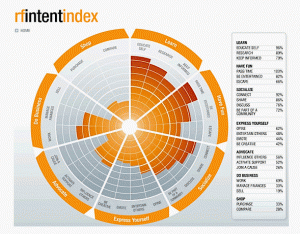 “‘Intent’ is the new demographic,” say the folks at Ruder Finn, the PR agency. What are people trying to achieve every moment of the digital day?
“‘Intent’ is the new demographic,” say the folks at Ruder Finn, the PR agency. What are people trying to achieve every moment of the digital day?
According to the firm’s Mobile Internet Index, people are spending 2.7 hours a day on the mobile Internet. The Index survey studies what reasons people have for using their mobile phones. This isn’t about deep-dive education; instead, the mobile web is for connecting, quick transactions, life in-the-moment. Immediacy is the currency of the mobile web.
The illustration shows Ruder Finn’s first iteration of the Intent Index, which analyzed peoples’ use of the Internet, broadly (not just mobile).
The key ‘intents’ of mobile web users have to do with learning, having fun, socializing, personal expression, advocating, doing business, and shopping, according to Ruder Finn. Underneath these intents are actions: under “having fun,” for example, are being entertained or escaping; for “learning,” one can be keeping informed or educating oneself; and, as for “socializing,” there’s connecting but separately, discussing.
Health Populi’s Hot Points: Ruder Finn’s MII doesn’t break out “health” as a personal intention. But based on what we see in terms of peoples’ values in using the mobile web, we can intuit more than a few healthy uses for it.
Over-arching is the citizen’s value of immediacy. For the health-citizen, immediacy means access to support, nudging, clinical facts, and monitoring on a 24×7 basis if one chooses to most fully engage in managing a chronic condition, or staying well. Think of this as “health-intentioned.”
As B.J. Fogg, director of Stanford University’s Persuasive Technology Lab, wrote in Texting 4 Health, “We don’t merely adopt mobile devices: we marry them.” The mobile phone is with us for all the times we need to test our blood glucose, check whether a generic drug is available to subsitute a branded medication, or reach out for support from a fellow migraineur.
For those health citizens and providers who choose to take advantage of it, the mobile web will be the next platform for health — whether via cell phone for receiving messages via Text4Baby, via smartphone or full feature phone for managing carb intake via a health app like SparkPeople or Keas, or empowering health workers in Malawi through the open source network of FrontlineSMS:medic.




 I'm in amazing company here with other #digitalhealth innovators, thinkers and doers. Thank you to Cristian Cortez Fernandez and Zallud for this recognition; I'm grateful.
I'm in amazing company here with other #digitalhealth innovators, thinkers and doers. Thank you to Cristian Cortez Fernandez and Zallud for this recognition; I'm grateful. Jane was named as a member of the AHIP 2024 Advisory Board, joining some valued colleagues to prepare for the challenges and opportunities facing health plans, systems, and other industry stakeholders.
Jane was named as a member of the AHIP 2024 Advisory Board, joining some valued colleagues to prepare for the challenges and opportunities facing health plans, systems, and other industry stakeholders.  Join Jane at AHIP's annual meeting in Las Vegas: I'll be speaking, moderating a panel, and providing thought leadership on health consumers and bolstering equity, empowerment, and self-care.
Join Jane at AHIP's annual meeting in Las Vegas: I'll be speaking, moderating a panel, and providing thought leadership on health consumers and bolstering equity, empowerment, and self-care.